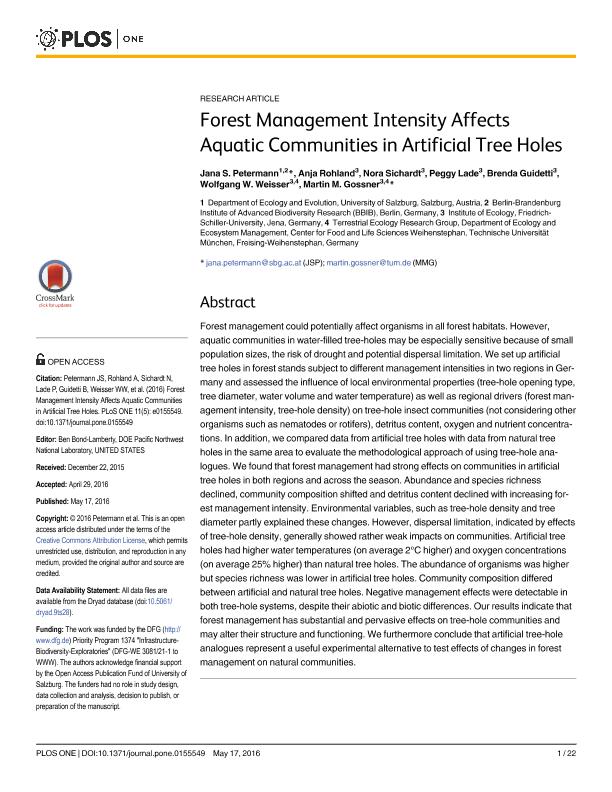Artículo
Forest management intensity affects aquatic communities in artificial tree holes
Petermann, Jana S.; Rohland, Anja; Sichardt, Nora; Lade, Peggy; Guidetti, Brenda Yamile ; Weisser, Wolfgang W.; Gossner, Martin M.
; Weisser, Wolfgang W.; Gossner, Martin M.
 ; Weisser, Wolfgang W.; Gossner, Martin M.
; Weisser, Wolfgang W.; Gossner, Martin M.
Fecha de publicación:
05/2016
Editorial:
Public Library of Science
Revista:
Plos One
ISSN:
1932-6203
Idioma:
Inglés
Tipo de recurso:
Artículo publicado
Clasificación temática:
Resumen
Forest management could potentially affect organisms in all forest habitats. However, aquatic communities in water-filled tree-holes may be especially sensitive because of small population sizes, the risk of drought and potential dispersal limitation. We set up artificial tree holes in forest stands subject to different management intensities in two regions in Germany and assessed the influence of local environmental properties (tree-hole opening type, tree diameter, water volume and water temperature) as well as regional drivers (forest management intensity, tree-hole density) on tree-hole insect communities (not considering other organisms such as nematodes or rotifers), detritus content, oxygen and nutrient concentrations. In addition, we compared data from artificial tree holes with data from natural tree holes in the same area to evaluate the methodological approach of using tree-hole analogues. We found that forest management had strong effects on communities in artificial tree holes in both regions and across the season. Abundance and species richness declined, community composition shifted and detritus content declined with increasing forest management intensity. Environmental variables, such as tree-hole density and tree diameter partly explained these changes. However, dispersal limitation, indicated by effects of tree-hole density, generally showed rather weak impacts on communities. Artificial tree holes had higher water temperatures (on average 2° C higher) and oxygen concentrations (on average 25% higher) than natural tree holes. The abundance of organisms was higher but species richness was lower in artificial tree holes. Community composition differed between artificial and natural tree holes. Negative management effects were detectable in both tree-hole systems, despite their abiotic and biotic differences. Our results indicate that forest management has substantial and pervasive effects on tree-hole communities and may alter their structure and functioning. We furthermore conclude that artificial tree-hole analogues represent a useful experimental alternative to test effects of changes in forest management on natural communities.
Palabras clave:
Forest Management
,
Aquatic Communities
,
Artificial Tree Holes
Archivos asociados
Licencia
Identificadores
Colecciones
Articulos(IEGEBA)
Articulos de INSTITUTO DE ECOLOGIA, GENETICA Y EVOLUCION DE BS. AS
Articulos de INSTITUTO DE ECOLOGIA, GENETICA Y EVOLUCION DE BS. AS
Citación
Petermann, Jana S.; Rohland, Anja; Sichardt, Nora; Lade, Peggy; Guidetti, Brenda Yamile; et al.; Forest management intensity affects aquatic communities in artificial tree holes; Public Library of Science; Plos One; 11; 5; 5-2016; 1-22
Compartir
Altmétricas



